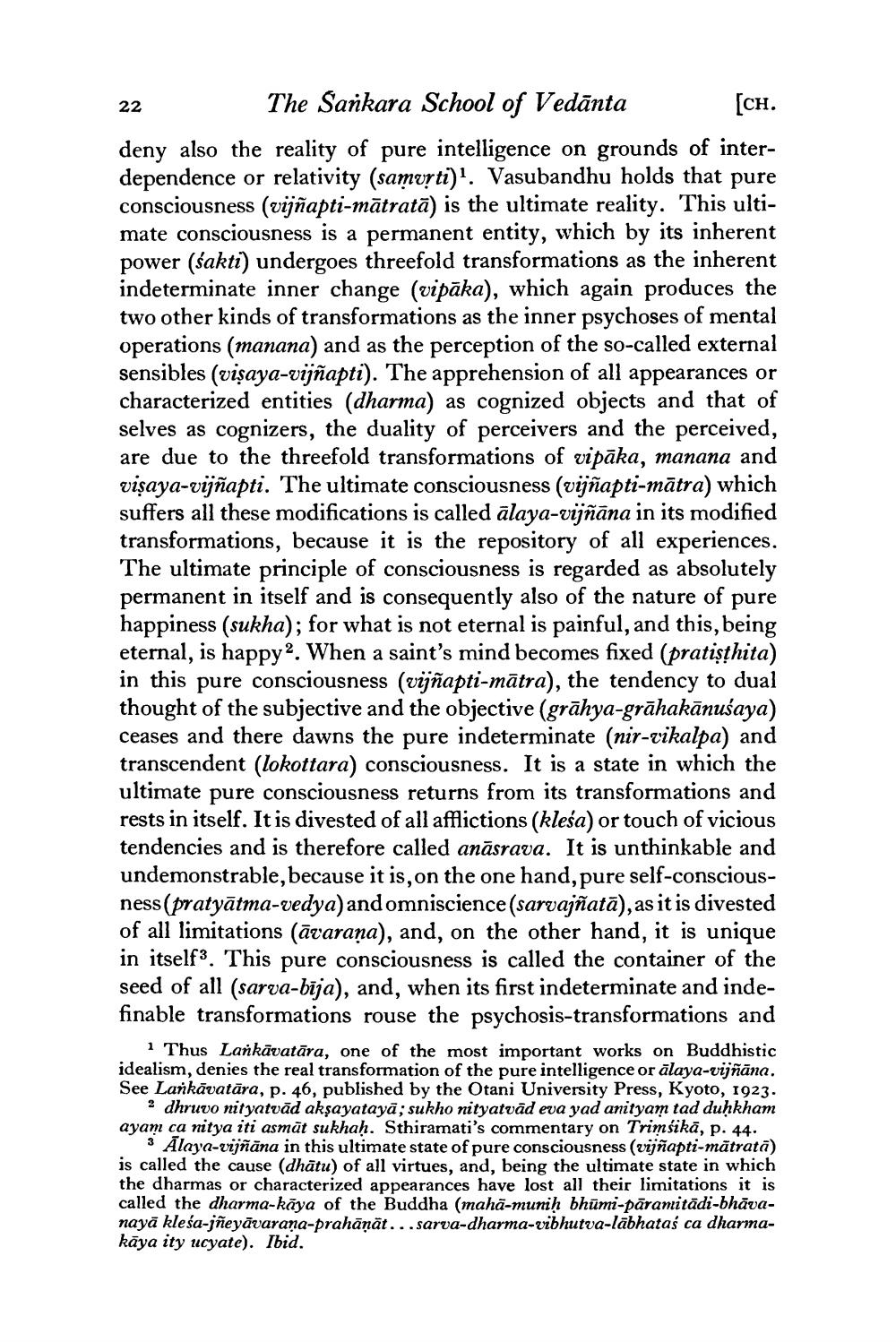________________
22
The Sankara School of Vedānta
[CH. deny also the reality of pure intelligence on grounds of interdependence or relativity (samurti)". Vasubandhu holds that pure consciousness (vijñapti-mātratā) is the ultimate reality. This ultimate consciousness is a permanent entity, which by its inherent power (sakti) undergoes threefold transformations as the inherent indeterminate inner change (vipāka), which again produces the two other kinds of transformations as the inner psychoses of mental operations (manana) and as the perception of the so-called external sensibles (vişaya-vijñapti). The apprehension of all appearances or characterized entities (dharma) as cognized objects and that of selves as cognizers, the duality of perceivers and the perceived, are due to the threefold transformations of vipāka, manana and visaya-vijñapti. The ultimate consciousness (vijñapti-mātra) which suffers all these modifications is called alaya-vijñāna in its modified transformations, because it is the repository of all experiences. The ultimate principle of consciousness is regarded as absolutely permanent in itself and is consequently also of the nature of pure happiness (sukha); for what is not eternal is painful, and this, being eternal, is happy. When a saint's mind becomes fixed (pratisthita) in this pure consciousness (vijñapti-mātra), the tendency to dual thought of the subjective and the objective (grāhya-grāhakānuśaya) ceases and there dawns the pure indeterminate (nir-vikalpa) and transcendent (lokottara) consciousness. It is a state in which the ultimate pure consciousness returns from its transformations and rests in itself. It is divested of all afflictions (klesa) or touch of vicious tendencies and is therefore called anāsrava. It is unthinkable and undemonstrable, because it is on the one hand, pure self-consciousness(pratyātma-vedya) and omniscience (sarvajñatā), as it is divested of all limitations (ārarana), and, on the other hand, it is unique in itself3. This pure consciousness is called the container of the seed of all (sarva-bīja), and, when its first indeterminate and indefinable transformations rouse the psychosis-transformations and
1 Thus Lankāvatāra, one of the most important works on Buddhistic idealism, denies the real transformation of the pure intelligence or ālaya-vijñāna, See Lankāvatāra, p. 46, published by the Otani University Press, Kyoto, 1923.
2 dhruvo nityatvād akşayatayā; sukho nityatvād eva yad anityam tad duḥkham ayam ca nitya iti asmāt sukhaḥ. Sthiramati's commentary on Trimsikā, p. 44.
3 Alaya-vijñāna in this ultimate state of pure consciousness (vijñapti-mătrată) is called the cause (dhātu) of all virtues, and, being the ultimate state in which the dharmas or characterized appearances have lost all their limitations it is called the dharma-kāya of the Buddha (mahā-munih bhūmi-pāramitādi-bhāvanayā klesa-jñeyāvarana-prahāņāt... sarva-dharma-vibhutva-lābhataś ca dharmakāya ity ucyate). Ibid.




